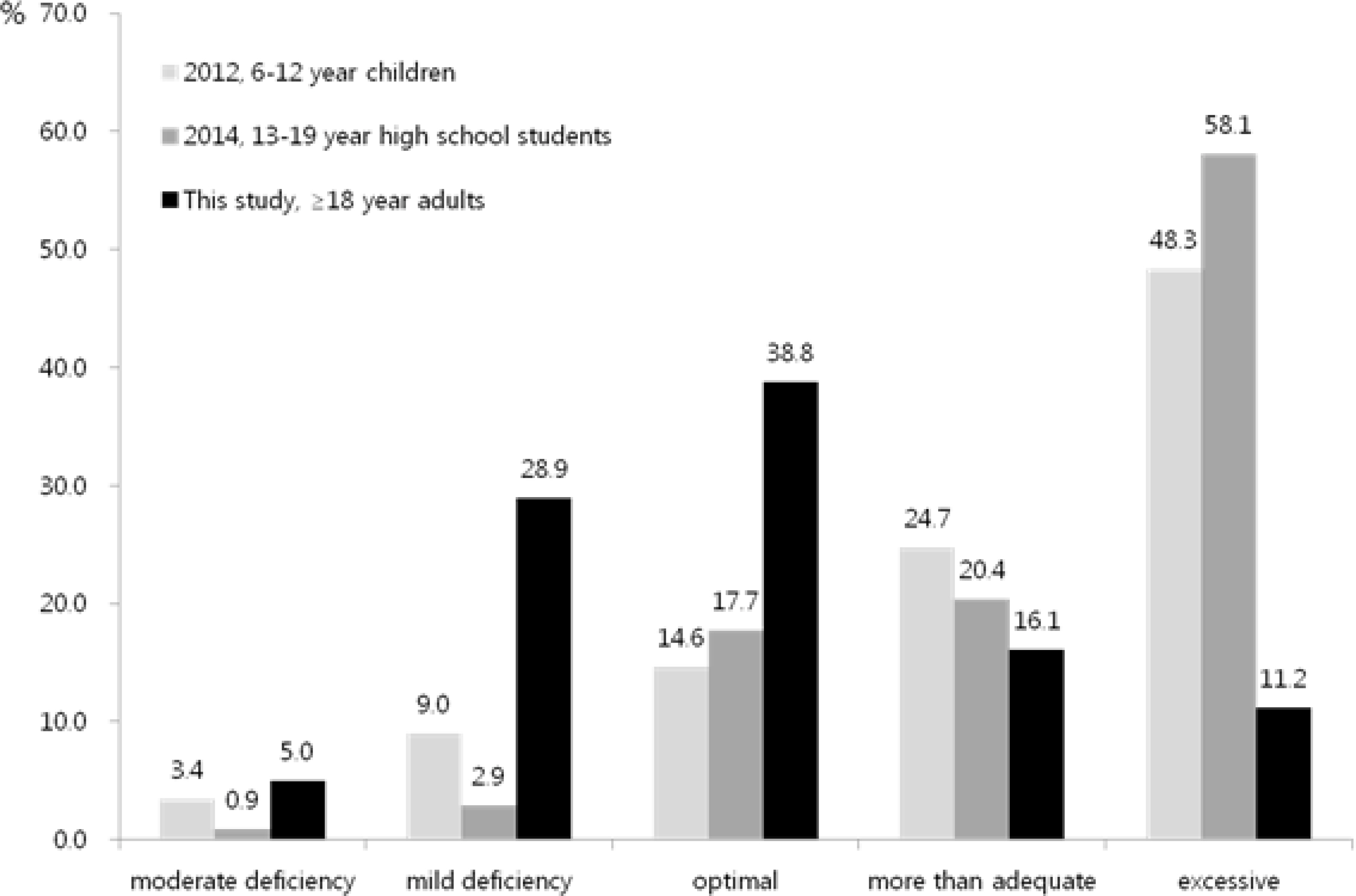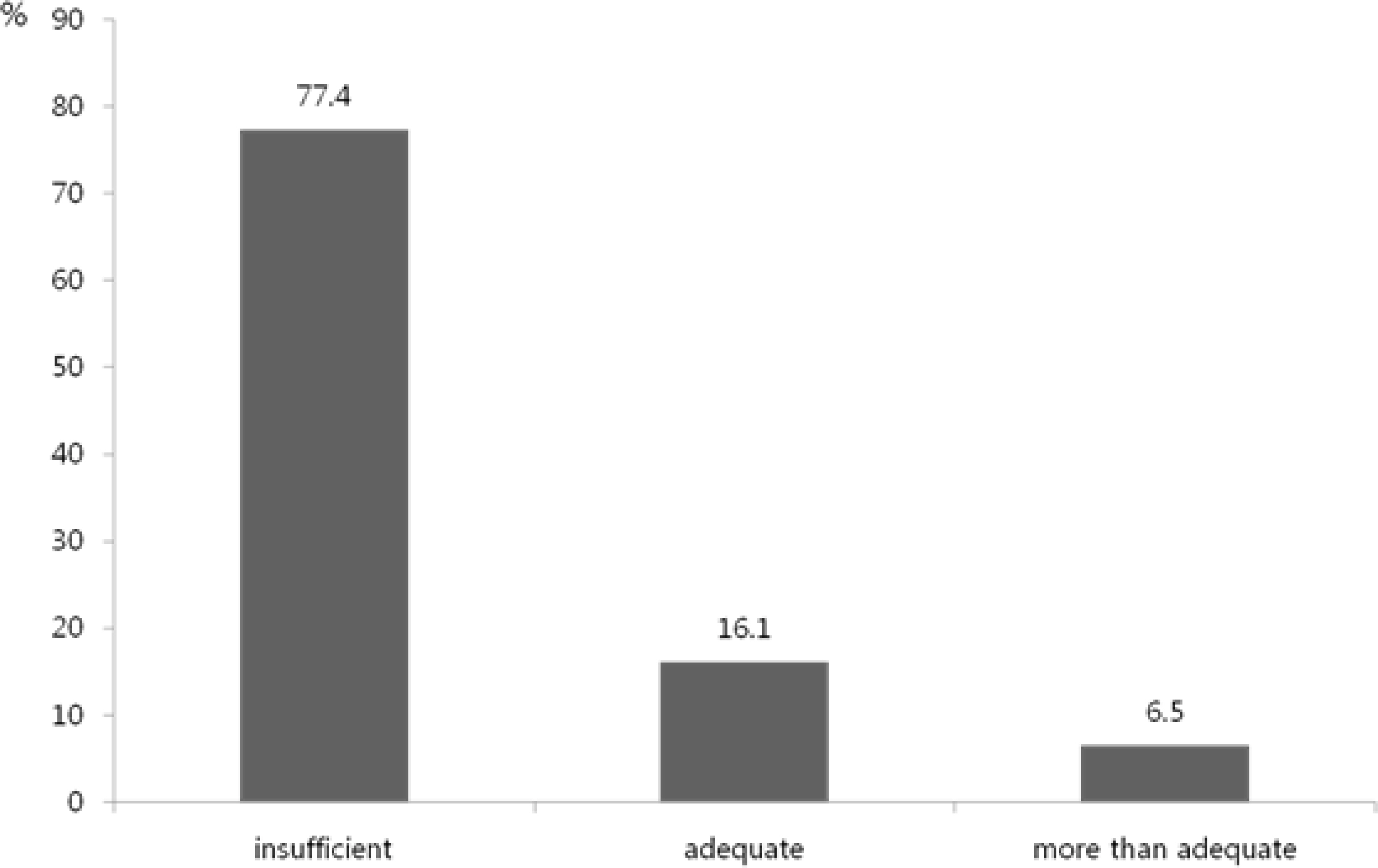Articles
- Page Path
- HOME > Kosin Med J > Volume 33(1); 2018 > Article
-
Original Article
Iodine nutritional status and awareness of iodine deficiency among adults, including pregnant women, in Tuguegarao, Philippines - Young Sik Choi1,*, Kwang-Hyuk Seok2,3,*, Jong Jin Lee1, Gina Jieun Hong4, Pablo M. Afidchao5, Bu Kyung Kim1,†, Jee-Yeong Jeong2,3,†
-
Kosin Medical Journal 2018;33(1):64-74.
DOI: https://doi.org/10.7180/kmj.2018.33.1.64
Published online: January 21, 2018
1Department of Internal Medicine, Kosin University College of Medicine, Busan, Korea
2Department of Biochemistry, Kosin University College of Medicine, Busan, Korea
3Cancer Research Institute, Kosin University College of Medicine, Busan, Korea
4Department of Molecular and Cellular Biology, University of California, Berkeley, CA, USA
5Department of Pharmacology and Biochemistry, Cagayan State University College of Medicine, Tuguegarao, Philippines
- †Corresponding Author: Bu kyung Kim, Department of Internal Medicine, College of Medicine, Kosin University, 262, Gamchen-ro, Seo-gu, Busan 49267, Korea Tel: +82-51-990-6532 Fax: +82-51-990-3065 E-mail: 79kyung@hanmail.net
- *These authors contributed equall
Copyright © 2018 Kosin University School of Medicine Proceedings
This is an Open Access article distributed under the terms of the Creative Commons Attribution Non-Commercial License (http://creativecommons.org/licenses/by-nc/4.0/) which permits unrestricted non-commercial use, distribution, and reproduction in any medium, provided the original work is properly cited.
- 1,177 Views
- 5 Download
Abstract
-
Objectives
- Iodine deficiency causes multiple health problems. Previously we reported that 96% of high school students in Tuguegarao, Philippines had adequate iodine levels. However, iodine deficiency-associated problems remain among adults in the Philippines. Therefore, we evaluated iodine nutritional status and goiter prevalence among adults, including pregnant women, in Tuguegarao, Philippines.
-
Methods
- A total of 245 adults, including 31 pregnant women, provided samples for urinary iodine analysis, and all pregnant women completed a questionnaire about iodine deficiency.
-
Results
- The median urinary iodine level was 164.0 ± 138.4 g/L; 38.4% of the participants were iodine deficient, according to the International Council for Control of Iodine Deficiency Disorders (ICCIDD) criteria. No severe iodine deficiency was observed. Among the 31 pregnant women, 24 (77.5%) fell into the iodine deficient category defined by a stricter World Health Organization (WHO) guideline, in which iodine deficiency is considered when urinary iodine levels are below 150 g/L. Almost half (42%) of the pregnant women were unaware of the harmful effects of iodine deficiency on the human body and their fetus.
-
Conclusions
- Although iodine nutritional status in the Philippines has improved, iodine deficiency still exists among adults, especially among pregnant women. Therefore, our study strongly suggests that a better strategy should be established to monitor iodine nutritional status among adults continually, and to focus on populations susceptible to iodine deficiency, including pregnant women and women of reproductive age, to achieve the total elimination of iodine deficiency.

| Median (μg/L) | UIC* | Iodine nutritional status for general population |
|---|---|---|
| < 20 | Severe iodine deficiency | |
| 20 - 49 | Moderate iodine deficiency | |
| 50 - 99 | Mild iodine deficiency | |
| 100 - 199 | Optimal | |
| 200 - 299 | More than adequate | |
| ≥ 300 | Excessive | |
| < 150 | Insufficient | |
| 150 - 249 | Adequate | |
| 250 - 499 | More than adequate | |
| ≥ 500 | Excessive |
| Men | Women | Pregnant women | P-value* | |
|---|---|---|---|---|
| Number | 49 | 188 | 31 | |
| Age (years) | 50.29 ± 17.9 | 44.8 ± 16.4 | 25.9 ± 7.3 | < 0.01 |
| Height (cm) | 164.5 ± 12.8 | 153.8 ± 6.1 | 155.8 ± 4.0 | 0.12 |
| Body weight (kg) | 57.9 ± 13.7 | 51.2 ± 10.6 | 57.0 ± 6.5 | 0.01 |
| BMI (kg/m2) | 21.3 ± 3.9 | 21.6 ± 3.8 | 23.4 ± 2.8 | 0.02 |
| Median UIC (μg/L) | 152.7 ± 174.5 | 180.8 ± 147.3 | 119.4 ± 94.9 | 0.02 |
- 1.Zimmermann MB. Iodine deficiency and excess in children: worldwide status in 2013. Endocr Pract 2013;19:839–46.ArticlePubMed
- 2.An Act Promulgating Salt Iodization Nationwide and for Related Purposes (ASIN LAW) and its Implementing Rules and Regulations, Republic Act 1995.
- 3.WHO/ICCIDD. Combating iodine deficiency in the Philippines through advocacy and partnership with the salt industry IDD newsletter. Vol 382010..
- 4.Berbel P, Mestre JL, Santamaria A, Palazon I, Franco A, Graells M, et al. Delayed neuro-behavioral development in children born to pregnant women with mild hypothyroxinemia during the first month of gestation: the importance of early iodine supplementation. Thyroid 2009;19:511–9.ArticlePubMed
- 5.Moreno-Reyes R, Glinoer D, Van Oyen H, Vandevijvere S. High prevalence of thyroid dis-orders in pregnant women in a mildly iodine-deficient country: a population-based study. J Clin Endocrinol Metab 2013;98:3694–701.ArticlePubMed
- 6.Vermiglio F, Lo Presti VP, Moleti M, Sidoti M, Tortorella G, Scaffidi G, et al. Attention deficit and hyperactivity disorders in the offspring of mothers exposed to mild-moderate iodine deficiency: a possible novel iodine deficiency disorder in developed countries. J Clin Endocrinol Metab 2004;89:6054–60.ArticlePubMed
- 7.WHO/ICCIDD. Assessment of Iodine Deficiency Disorders and Monitoring their Elimination: A Guide for programme Managers. 3rd ed.Egneva; Switzerland: 2007.
- 8.Bath SC, Steer CD, Golding J, Emmett P, Rayman MP. Effect of inadequate iodine status in UK pregnant women on cognitive outcomes in their children: results from the Avon Longitudinal Study of Parents and Children (ALSPAC). Lancet 2013;382:331–7.ArticlePubMed
- 9.Cho YY, Kim HJ, Oh SY, Choi SJ, Lee SY, Joung JY, et al. Iodine status in healthy pregnant women in Korea: a first report. Eur J Nutr 2016;55:469–75.ArticlePubMed
- 10.Kim BK, Jeong JY, Seok KH, Lee AS, Oak CH, Kim GC, et al. Current iodine nutrition status and awareness of iodine deficiency in tuguegarao, Philippines. Int J Endocrinol 2014;2014:210528.ArticlePubMedPMC
- 11.Wuethrich C, Jaeggi-Groisman SE, Gerber H. Comparison of two methods for the detection of urinary iodine used in epidemiological studies. Clin chem Lab Med 2000;38:1027–31.ArticlePubMed
- 12.(CDC) CfDCap. Ensuring the Quality of Urinary Iodine Procedures (EQUIP) In: Health E, ed. Atlanta GA..
- 13.WHO/ICCIDD. Assessment of Iodine Deficiency Disorders and Monitoring Their Elimination: a guide for program managers. Geneva; Switzerland 2001.
- 14.Patrick L. Iodine: deficiency and therapeutic considerations. Altern Med Rev 2008;13:116–27.PubMed
- 15.Fuge R. Iodine deficiency: an ancient problem in a modern world. Ambio 2007;36:70–2.ArticlePubMed
- 16.WHO/UNICEF/ICCIDD. Indicators for Assessment of Iodine Deficiency Disorders and Their Control Progranners: report of a Joint WHO/UNICEF/ICCIDD Consultation. In: WHO/NUT/93.1 D, ed Geneva; WHO; 1993.
- 17.UNICEF. Iodine Deficiency Disorders and Universal Salt Iodisation: South Asia Priorities. New York United Nations Childern's Fund (UNICEF) 2002.
- 18.WHO/ICCIDD. Steady progress against IDD in the Philippines. IDD Newsletter Vol.22:2003;1–6.
- 19.Tanchoco C, Cilindro P, Pingl M, Magbitang J, Flores E, Mendoza S. Third Nutrition Survey. Clinical and Anthropometric Phase 1987. JPMA 1990;66:33–49.
- 20.Kim BK, Choi YS, Oak CH, Park YH, Kim JH, Park DJ, et al. Determination of thyroid volume by ultrasonography among schoolchildren in Philippines. Int J Endocrinol 2012;2012:387971.ArticlePubMedPMC
- 21.Delange F. Iodine requirements during pregnancy, lactation and the neonatal period and in-dicators of optimal iodine nutrition. Public Health Nutr 2007;10:1571–80. discussion 81-3..ArticlePubMed
- 22.Zimmermann MB, Gizak M, Abbott K, Andersson M, Lazarus JH. Iodine deficiency in pregnant women in Europe. Lancet Diabetes Endocrinol 2015;3:672–4.ArticlePubMed
- 23.Andersen SL. Iodine status in pregnant and breastfeeding women: a Danish regional investigation. Dan Med J 2015;62.
- 24.Granfors M. [Recent study shows iodine deficiency among pregnant women in Sweden]. Lakartidningen 2015;112.
- 25.Bath SC, Rayman MP. A review of the iodine status of UK pregnant women and its implications for the offspring. Environ Geochem Health 2015;37:619–29.ArticlePubMedPMC
- 26.Zygmunt A, Lewinski A. Iodine prophylaxis in pregnant women in Poland - where we are? (update 2015). Thyroid Res 2015;8:17.ArticlePubMedPMC
- 27.Rajatanavin R. Iodine deficiency in pregnant women and neonates in Thailand. Public Health Nutr 2007;10:1602–5.ArticlePubMed
- 28.Wu T, Liu GJ, Li P, Clar C. Iodised salt for preventing iodine deficiency disorders. Cochrane Database Syst Rev 2002;CD003204.Article
- 29.Zimmermann MB. The impact of iodised salt or iodine supplements on iodine status during pregnancy, lactation and infancy. Public Health Nutr 2007;10:1584–95.ArticlePubMed
References
Figure & Data
References
Citations


 KOSIN UNIVERSITY COLLEGE OF MEDICINE
KOSIN UNIVERSITY COLLEGE OF MEDICINE

 PubReader
PubReader Cite
Cite


